Thursday, October 23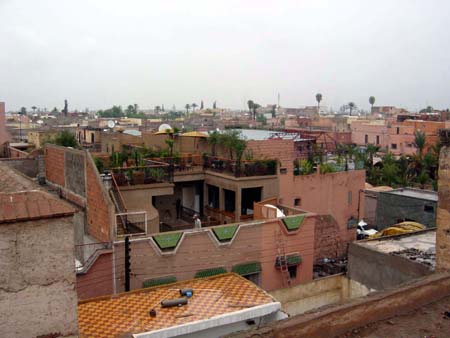
Steve and Paula: All our senses were awakened today in
Marrakech. We all felt like we were on the set of a movie - it seemed so unreal,
yet we knew that the people all around us were simply living their normal
daily lives. The sights, sounds and smells were all very different from anything
we've experienced before, and this all made for a wonderful and often enchanting
day. Unfortunately, the weather didn't cooperate (this was Morocco's first
real rain since April), but this didn't detract from our excitement as we
explored. 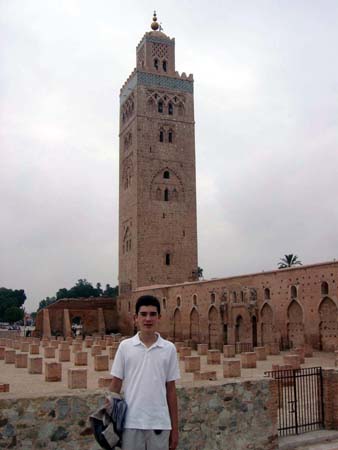
We spent the day with a guide (Ahmed), and started at the Koutoubia Mosque which sits just outside the Medina (old city). Ahmed began by telling us about the Koutoubia Mosque and the importance of Islam to the people of Marrakech. The mosque was built in the 12th Century and has one minaret. The minaret is quite different than the ones we saw in Istanbul - it appears more like a bell tower instead of the rounded minarets we saw in Turkey. Also, the mosques here only have one minaret - in Turkey the number of minarets varied based on the sources of funding from the construction of the mosques. The calls to prayers are still made from the tops of the minarets using loudspeaker, and these minarets dominate the landscape (nothing can be built higher). Ahmed indicated that Istanbul is more secular but that in Marrakech, Islam is a way of life. This has already been evident as we have seen people crowding in and out of the mosques, and also praying in the airport. Ramadan, where people fast between sunrise and sundown for 28 consecutive days, will actually begin during our stay here in Morocco.
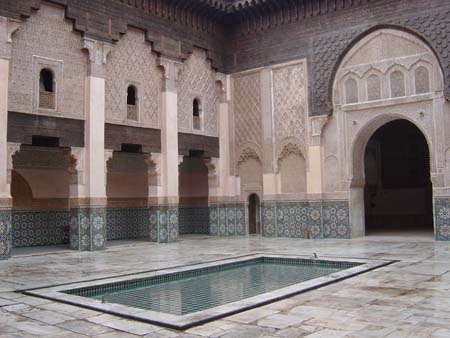 Given
the rain, we started by visiting several historical sites in the Medina, including
palaces, tombs and also a theological university from the 1500's.
Given
the rain, we started by visiting several historical sites in the Medina, including
palaces, tombs and also a theological university from the 1500's.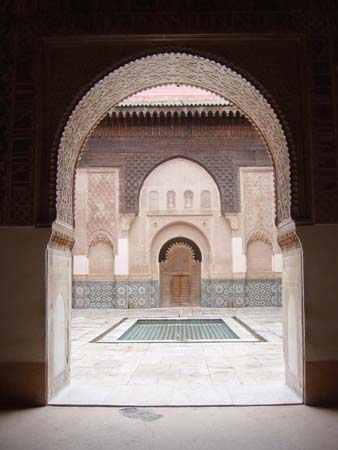 Unlike Istanbul, the mosques of Marrakech are not open to the public, so we
weren't able to visit any. Traditional architecture in Marrakech contains
four elements which are present in all the historical buildings we saw today.
These consist of the use of marble floors, cedar ceilings, mosaic clay tiles
and hand-chiseled plaster (made from clay and marble dust). The most beautiful
building we saw today was the Ben Youssef Medersa, which housed over 900 students
of Islam back in the 1500's. The mosaics and the carvings in the plaster and
cedar ceilings are particularly impressive. They contain geometric and flora
designs only - the Islam religion doesn't allow images of people or animals.
Unlike Istanbul, the mosques of Marrakech are not open to the public, so we
weren't able to visit any. Traditional architecture in Marrakech contains
four elements which are present in all the historical buildings we saw today.
These consist of the use of marble floors, cedar ceilings, mosaic clay tiles
and hand-chiseled plaster (made from clay and marble dust). The most beautiful
building we saw today was the Ben Youssef Medersa, which housed over 900 students
of Islam back in the 1500's. The mosaics and the carvings in the plaster and
cedar ceilings are particularly impressive. They contain geometric and flora
designs only - the Islam religion doesn't allow images of people or animals.
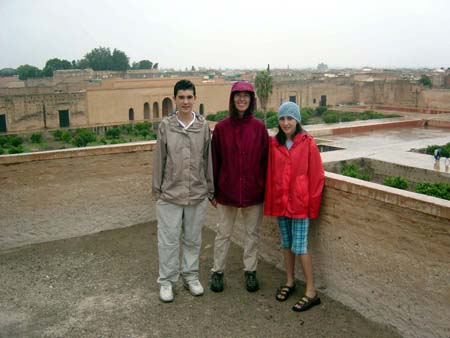 The
palace el-Badi is largely in ruins now (inhabited by several large storks
who live build nests on its walls), but it is possible to see the grand scale
of what once called one of the most beautiful palaces in the world. The Palais
de la Bahia, where the Grand Vizier (second in power after the Sultan) provided
an interesting view into the life of the Vizier and his four wives. This palace
is only 150 years old - it has no exterior windows, but was basically a private
enclave for the Vizier who lived
The
palace el-Badi is largely in ruins now (inhabited by several large storks
who live build nests on its walls), but it is possible to see the grand scale
of what once called one of the most beautiful palaces in the world. The Palais
de la Bahia, where the Grand Vizier (second in power after the Sultan) provided
an interesting view into the life of the Vizier and his four wives. This palace
is only 150 years old - it has no exterior windows, but was basically a private
enclave for the Vizier who lived 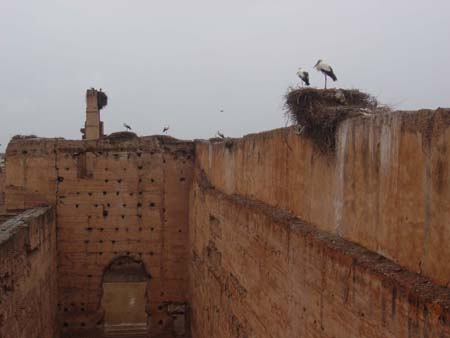 in
grand style.
in
grand style.
Fortunately, the rain let up a bit and we were able to walk through the streets
of the Medina. This was what we enjoyed most about our day today - observing
the people of Marrakech going about their daily lives. What seemed so normal
to all of them appeared totally foreign to us, and this is what made today
so special. This is low season for tourism here, and we were walking among
the local people who were working, shopping and socializing.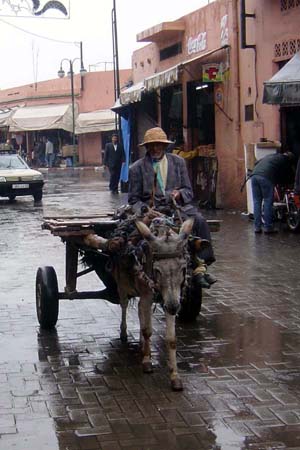
The streets are very active, and there are no rules regarding traffic. The streets and alleys are filled with all kinds of transportation - cars, mopeds, motorcycles, bikes, people pushing carts, mules and donkeys. The animals seem to have the same privileges as cars or men with carts, and the bikes are fearless. Pedestrians are on their own (there are no crosswalks) - Ahmed told us to simply follow him, which was often very difficult. Even in the narrow alleys of the Medina and in the souqs (the markets), bikes and mopeds honk their way through.
All of Marrakech's buildings are all built out of red clay. We learned that
the buildings in Marrakech are required to be of this traditional red to mesh
with the landscape and help absorb (rather than reflect) the bright sun. 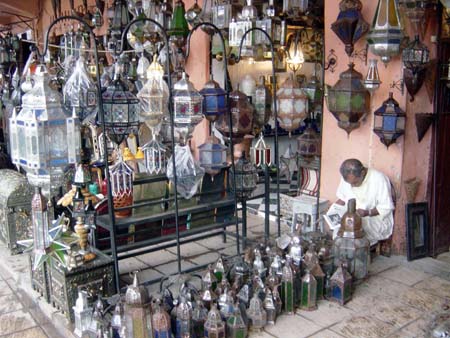
The narrow streets of the Medina are lined with tiny family-owned shops and
food stalls. In the many of the shops, we saw the owners making their crafts
including shoes, lanterns, baskets and clothing. The shops are all open and
are so small that the actual shopping happens from the street - the inside
of the shops are often mainly used as workshops.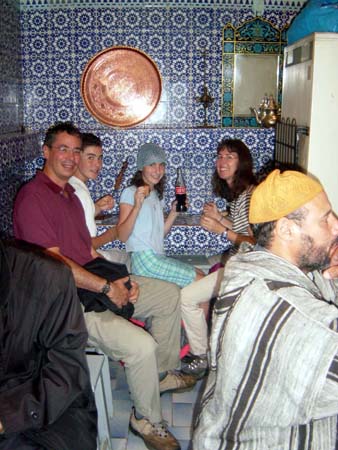
Ahmed offered to take us to a place with "the best shish kebab in Morocco",
an offer we couldn't refuse. This turned out to be a tiny restaurant (he called
it a restaurant, but we'd probably think of this much more as a hole in the
wall - literally!) with a man cooking meat on a very small grill. Ahmed explained
that the man has a secret recipe that no one else in Marrakech can duplicate,
and from what we experienced he may right. The food was absolutely fantastic,
and the experience squeezing next to the locals in this teeny little place
was unforgettable. There is no 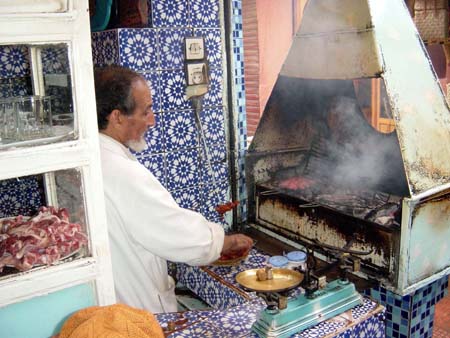 silverware
here - you use the bread to remove the meat from the skewers and eat with
your hands. By the way, using your left hand to eat is not allowed. In Islam,
the left hand is used in the bathroom, and you're supposed to eat using your
right hand (this was quite a problem today for Steve who is a lefty, and can't
use his right hand for hardly anything…).
silverware
here - you use the bread to remove the meat from the skewers and eat with
your hands. By the way, using your left hand to eat is not allowed. In Islam,
the left hand is used in the bathroom, and you're supposed to eat using your
right hand (this was quite a problem today for Steve who is a lefty, and can't
use his right hand for hardly anything…).
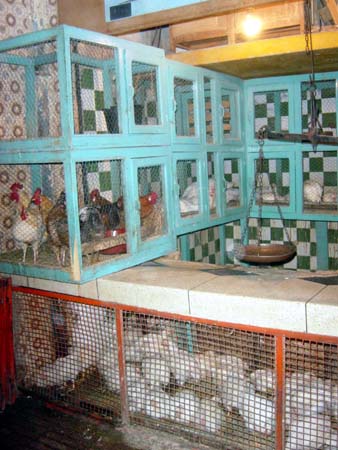 We
asked Ahmed to take us to the place where the local people shop for food.
As we walked into the food market, the first thing we saw was rows of caged
chickens and roosters. These birds are weighed, butchered and sold to customers
right in the market. We stopped to watch a poor bird be snatched from the
cage and weighed - however, it was spared when the customer was not able to
negotiate an acceptable price with the shop owner. Steve and David
We
asked Ahmed to take us to the place where the local people shop for food.
As we walked into the food market, the first thing we saw was rows of caged
chickens and roosters. These birds are weighed, butchered and sold to customers
right in the market. We stopped to watch a poor bird be snatched from the
cage and weighed - however, it was spared when the customer was not able to
negotiate an acceptable price with the shop owner. Steve and David 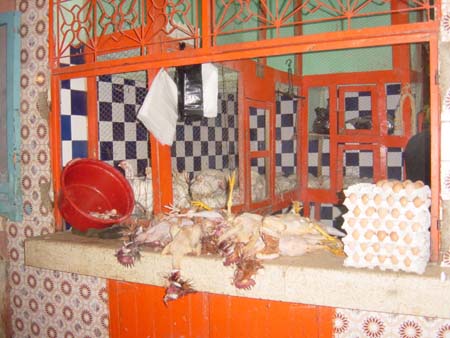 wanted
to see the actual butcher process, but Paula and Katie would have none of
it. So we had to settle instead with taking pictures (like the one here on
the right) of birds who had obviously very recently met their fates…
The smells of this market weren't particularly appetizing to us - the mix
of odors emanating from the birds, fish and meat all in an enclosed area was
very overpowering. This particular market also has shops selling fruits, vegetables,
olives, bread and canned goods, all interspersed with the
wanted
to see the actual butcher process, but Paula and Katie would have none of
it. So we had to settle instead with taking pictures (like the one here on
the right) of birds who had obviously very recently met their fates…
The smells of this market weren't particularly appetizing to us - the mix
of odors emanating from the birds, fish and meat all in an enclosed area was
very overpowering. This particular market also has shops selling fruits, vegetables,
olives, bread and canned goods, all interspersed with the 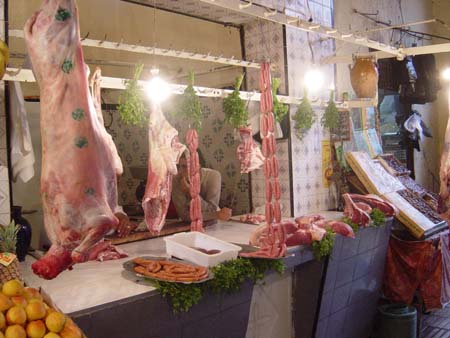 poultry,
seafood and meat. Ahmed explained that this is Marrakech's version of a supermarket,
and that people come to the market every single day. People decide on the
menus for the day after they arrive at the market, and they buy just enough
food for each day's meals.
poultry,
seafood and meat. Ahmed explained that this is Marrakech's version of a supermarket,
and that people come to the market every single day. People decide on the
menus for the day after they arrive at the market, and they buy just enough
food for each day's meals.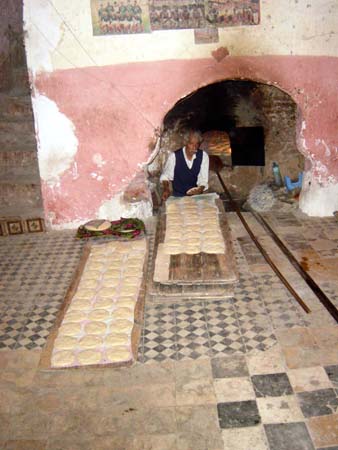
Ahmed also took us to the local bakery, which was fascinating. This is where people bring their own dough in to be baked. The man (seen here on the right) who owns the bakery has been doing this his entire life, and basically knows everyone. He also knows who makes the best bread, and can tell who owns which bread simply by how it looks (there are no tags or labels on the cooked loaves). The oven in the bakery is huge, and we watched the man skillfully arrange and maneuver large numbers of loaves that were baking today. We were even offered a sample from a freshly baked loaf, and it was wonderful!
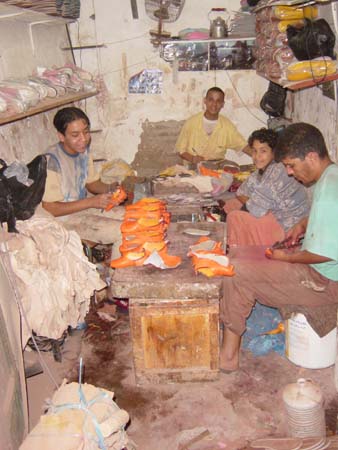 We
took a break at our hotel to rest (and dry off!) before returning for the
Medina to spend time in the souqs and the Djemaa el-Fna, Marrakech's main
square. The souqs are very small markets, often combined with a workshop.
There are over 2,000 shops here, and they are organized into areas among a
huge labyrinth. The main areas of the souqs include leather, metal, fabric,
footwear and ceramics. The price for everything sold in the souqs is negotiated
- this is true for the locals and for visitors. Most everyone we saw here
today were local residents - this is where the people of
We
took a break at our hotel to rest (and dry off!) before returning for the
Medina to spend time in the souqs and the Djemaa el-Fna, Marrakech's main
square. The souqs are very small markets, often combined with a workshop.
There are over 2,000 shops here, and they are organized into areas among a
huge labyrinth. The main areas of the souqs include leather, metal, fabric,
footwear and ceramics. The price for everything sold in the souqs is negotiated
- this is true for the locals and for visitors. Most everyone we saw here
today were local residents - this is where the people of 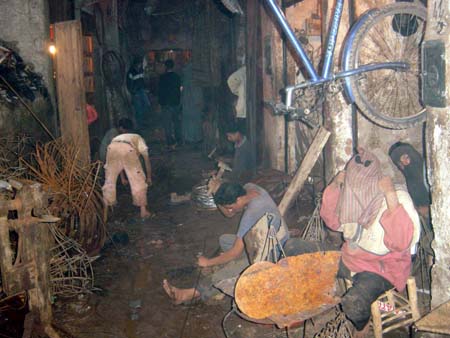 Marrakech
can come to buy almost anything they need for their homes (we even saw televisions
and other electronics being sold here).
Marrakech
can come to buy almost anything they need for their homes (we even saw televisions
and other electronics being sold here).
The thing that really made this experience different for us was seeing the
actual workshops in the souqs. We watched people making shoes, baskets, lanterns
and clothing. The metal work area was filled with 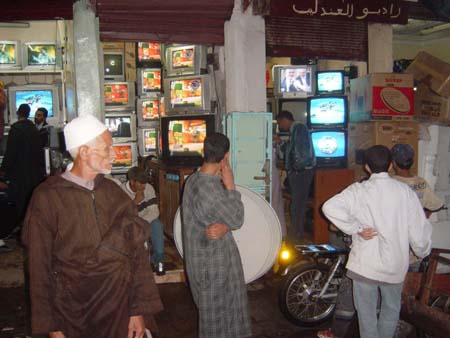 young
men welding and pounding. It was dark and wet from today's rain, and with
the noise and smells almost had the feel of a small factory. We were able
to take a few pictures of the people at work, but only after getting permission
and negotiating a small price.
young
men welding and pounding. It was dark and wet from today's rain, and with
the noise and smells almost had the feel of a small factory. We were able
to take a few pictures of the people at work, but only after getting permission
and negotiating a small price.
We did buy a few small items (including a candle-lit lantern) here, but David
and Katie really don't like the whole price negotiation process so we limited
our shopping. It was more fun to simply wander and observe, and Ahmed told
us that we covered nearly all of the souqs today. 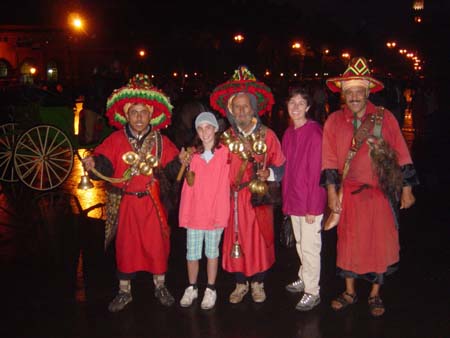
After the souqs we ventured into the Djemaa el-Fna, the main square in Marrakech.
Djemaa el-Fna is Arabic for "place of death", because this is where
people used to come to watch public executions. Today, the Djemaa el-Fna is
still famous for its entertainers, but of a very different kind. A huge number
of performers gather here each evening, including snake charmers, story tellers,
dancers and acrobats. Today's rainy weather made the square less active than
normal (apparently the 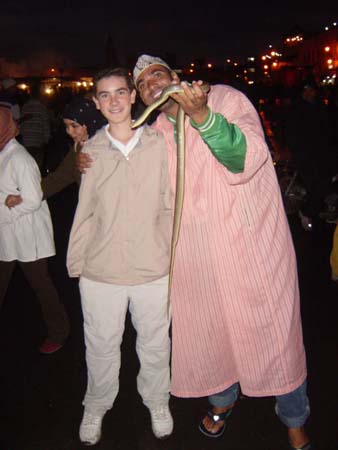 snakes
don't like the cold!), but it was still fun to see all the action. The spectators
are not visitors (as is the case in so many other places we've been), but
are mainly local people who come here at night to be entertained. We stopped
to see some of the dancing and the snake charmers, but look forward to returning
on another evening with hopefully some better weather. The snakes that we
saw very definitely did not have their mouths stitched shut as our book suggested
they might -
snakes
don't like the cold!), but it was still fun to see all the action. The spectators
are not visitors (as is the case in so many other places we've been), but
are mainly local people who come here at night to be entertained. We stopped
to see some of the dancing and the snake charmers, but look forward to returning
on another evening with hopefully some better weather. The snakes that we
saw very definitely did not have their mouths stitched shut as our book suggested
they might - 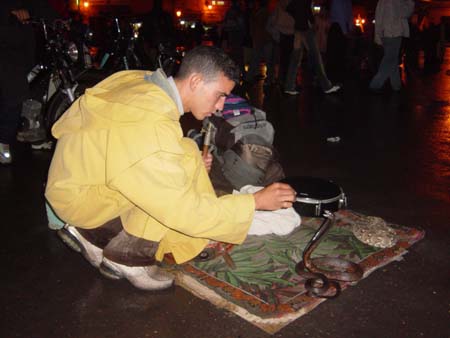 Ahmed
confirmed that in fact these guys are not friendly and are plenty dangerous.
We were also approached by an array of people carrying monkeys and a variety
of snakes - we weren't interested in handling any, but finally gave in to
a few pictures.
Ahmed
confirmed that in fact these guys are not friendly and are plenty dangerous.
We were also approached by an array of people carrying monkeys and a variety
of snakes - we weren't interested in handling any, but finally gave in to
a few pictures.
The other half of the Djemaa el-Fna is filled with food stalls that get set
up each night. These stalls sell a huge variety of food, some it very exotic.
There is the standard selection of shish kebabs and soups. However, much to
Katie's (the sheep-lover of the family) dismay, we also saw the heads and
brains of lamb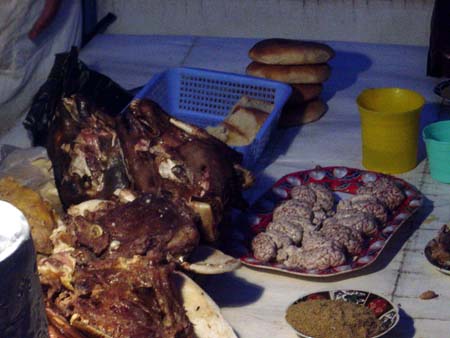 s
(pictured here) being served! There are also huge stalls where snails are
served - there's a man perched above each eating area who cooks the snails
in large pots.
s
(pictured here) being served! There are also huge stalls where snails are
served - there's a man perched above each eating area who cooks the snails
in large pots.
We are overwhelmed with the friendliness of the people here. This includes
shopkeepers, taxi drivers, children on the street, and the people in the hotels
and restaurants. Everyone is unbelievably helpful, and people openly smiled
and interacted with us today. Local people seem genuinely interested in pleasing
us and creating a positive experience for all visitors. We don't remember
being so impressed with the warmth of the people in any other place we've
visited.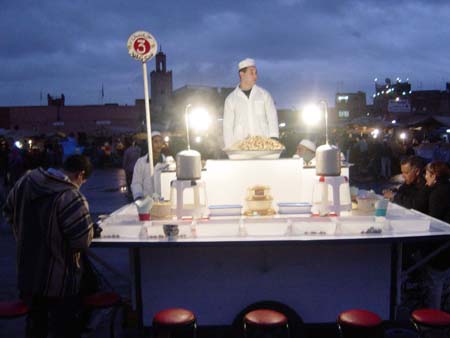
Most people in Morocco speak at least three, and often four or more languages.
Everyone speaks Arabic, Berber and French (Morocco was originally a French
protectorate, and gained its independence in the late 1950's). Many of the
younger people also speak English, since it's introduced into the schools
at age 13. The law requires children to attend school from age 7-16. The country
of Morocco faces a huge illiteracy problem (over 30% of men and 60% of women
can't read or write), and we saw some evidence of this with people working
as scribes today. They sit in the square and get paid to 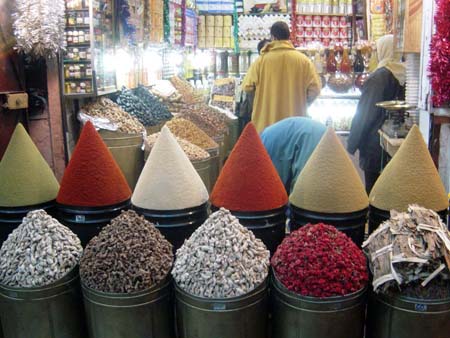 write
for people who can't do it on their own. Conversation on the street is all
Arabic and Berber, and is often conducted very loudly (we were told that it's
all friendly, but it often appears to us as though the people are arguing).
In the restaurants and hotels, the first language spoken is French, so Steve
has continued to employ his broken French as our primary means of communication.
write
for people who can't do it on their own. Conversation on the street is all
Arabic and Berber, and is often conducted very loudly (we were told that it's
all friendly, but it often appears to us as though the people are arguing).
In the restaurants and hotels, the first language spoken is French, so Steve
has continued to employ his broken French as our primary means of communication.
Most of the visitors we saw today appear to be from France - we also saw
a few British travelers, but no Americans. Ahmed told us that there are very
few Americans who come here now. We asked about anti-Americanism, and Ahmed
said that in his opinion, it's not present. He said that the people clearly
don't like our President, but that they find the 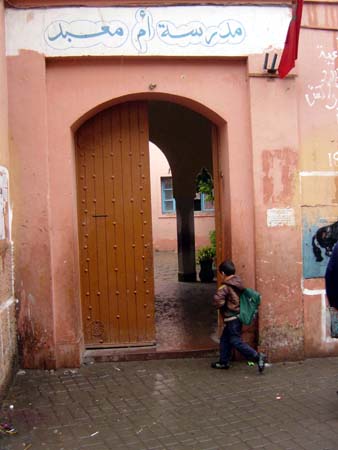 Americans
who visit Morocco to be good people. We certainly didn't feel any anti-American
sentiments today, and felt comfortable all day.
Americans
who visit Morocco to be good people. We certainly didn't feel any anti-American
sentiments today, and felt comfortable all day.
We saw cats everywhere today, which is consistent of what we had read about
Morocco. There's a story about how a cat gave birth on Mohammad's robe while
he was sitting, and Mohammad cut the cloth of his robe so as not to disturb
the cat. Because of this, cats are considered to be clean and are respected
here. However, dogs are thought by Muslims to be unclean, and so they're much
less common - we didn't see any dogs today.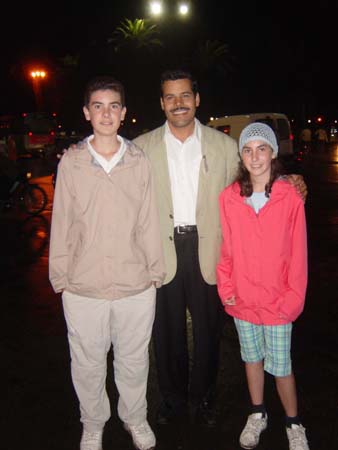
The women in the Medina all have their heads covered, but it's an individual decision as to how much of the face is covered. We saw many women with nothing over their faces, and many others who were totally covered. The men wear a variety of clothes and head coverings. Several of the robes are representative of particular Berber tribes, and Ahmed was able to recognize several based on their styles and colors.
This was a great day for us, and we were pleased that David and Katie found this to be very special. Tomorrow we'll head back into the Medina for more wandering and exploration, and plan to have a special dinner at one of the top Moroccan restaurants here.
Distance Walked: 2.31 miles
